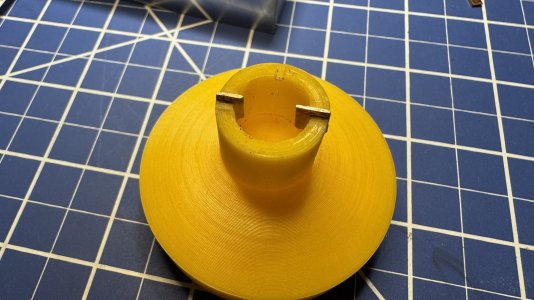A traditional spanner with metal blades would be stronger and more likely to work. But they require a bit of skill to use and I'm certain many a retaining ring has been marred by poor technique. And I'm sure some have even slipped onto the glass elements causing even greater damage.
But there may be a way to mod your tool to get it to do the job. It appears you're relying on just the plastic tabs to exert pressure on the retaining ring, and as you've demonstrated, they are too fragile for the task. They are breaking before the retaining ring comes loose.
But, if you put a sticky substance -- such as sticky rubber or maybe even double sided tape -- on the flat, circular part of the tool and then push the tool into the retaining ring with greater downward force than circular force as you turn it, you'd be redirecting and redistributing the forces to the much larger, flat area. That should stand a significantly better chance of getting the retaining ring loose and it shouldn't pose any significantly greater risks to the lens, unless, of course, you push with such force as to break the tool into pieces.
If it were my lens and tool, I'd probably try it, while being mindful of the forces exerted.
p.s., just a couple drops of alcohol or acetone at the junction between the retaining ring and outer wall might help. But use very sparingly to avoid contaminating the optics.
Thanks so much for your thoughtful and helpful reply.
I tried rubber and sticky tape as you suggested, but neither worked well. I also combined them with both acetone and alcohol, but the element wouldn't budge.
I ended printing a new spanner tool and cut slots in it so I could glue 1mm thick copper pieces. I chose copper because it's roughly the same hardness as brass and was less likely to scratch. The spanner exactly fit in the lock ring, almost impossible to slip, but the element still wouldn't budge, even with alcohol and acetone.
So, here's what worked:
1) Glued (with super glue, very sparingly) the base of the optical block to a steel block, to provide traction. I chose super glue because it's removable with acetone.
2) Applied a small amount of lightweight oil (sewing machine oil) to the exposed threads & tried unscrewing after an hour or so, but still wouldn't budge.
3) Applied a small amount of acetone with a syringe, hoping to both push the oil into the threads, and to dissolve the paint that I suspected was locking the screws.
The combination of these 3, plus the custom spanner too, were what worked. Gluing the block to the steel plate kept it from moving, and the oil + acetone dissolved enough of whatever was gumming up the threads that I was able to get the element moving, the spanner tool provided the torque I needed.
Once the element out it out it was clear what was happening. Leica painted the threads with the same light blocking material the used inside the optical block and it had hardened over the years. Why they painted the threads, I have no idea, except maybe it was easier just to paint the whole element. I removed as much of the paint as I could from the threads with acetone & a q-tip and now it screws in and out very smoothly.
The rest was relatively easy... removed the remaining lens elements, cleaned everything, re-assembled the lens, and now the lens it's haze-free and working well. I suspect the helicoid grease is what caused the haze in the first place, but the focus is working smoothly & maybe it's outgassed as much as it's going to, so I didn't mess with the helicoid.
One odd thing was that the rangefinder focus was off after re-assembly. I hadn't tested the foucus before opening up the lens, so I'm not sure if it was always off. I thought I might have mis-assembled the elements but they all look correct. Maybe someone else had been inside the lens before me I lost a spacing element, or I misplaced a spacer ring after opening up the lens? Fortunately I had some shim material, did a few calculations, & made an 0.1 um shim which fixed the focus.
Thanks again for your help!




